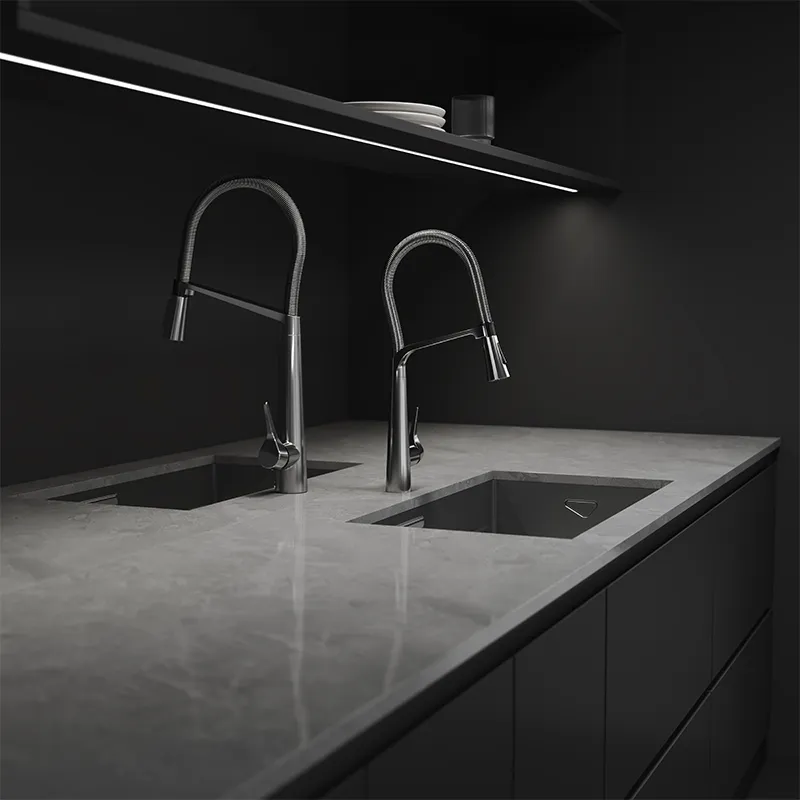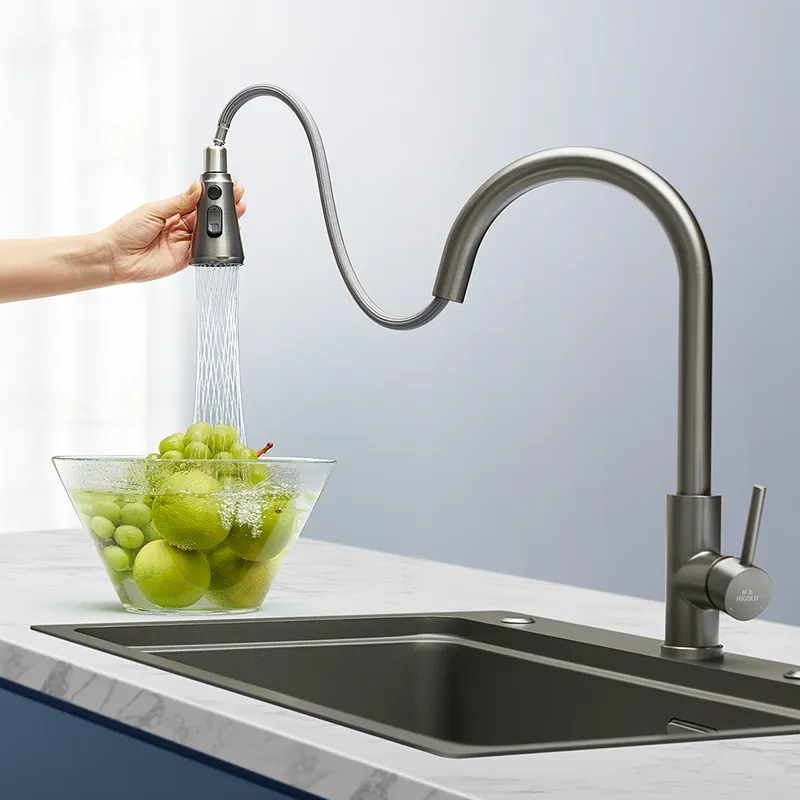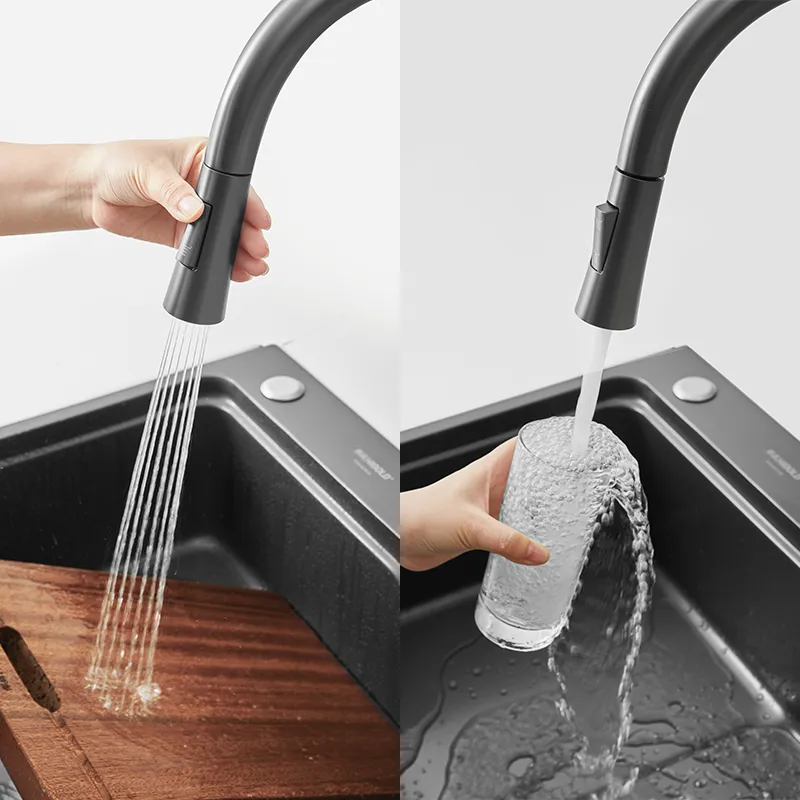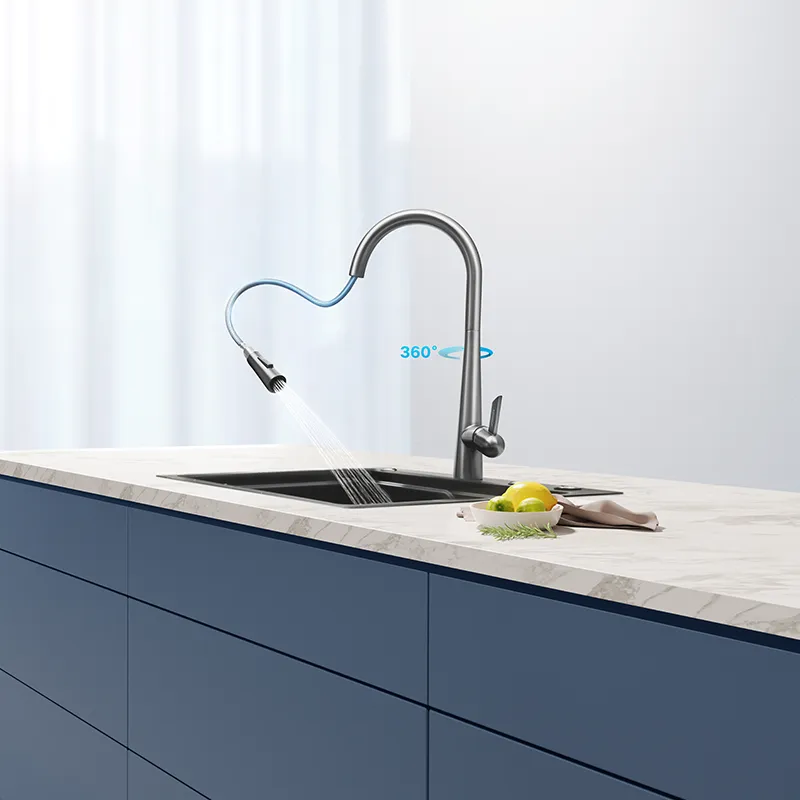The design of the kitchen sink and faucet is an aspect that cannot be ignored in the modern kitchen. It not only directly affects the aesthetics of the kitchen, but is also closely related to the convenience and comfort of daily use. As one of the core facilities of the kitchen, the installation height of the sink faucet has a vital impact on the experience of kitchen use.
However, many people do not know how to determine the optimal installation height of the kitchen sink faucet. Improper installation may affect the comfort of operation and even cause unnecessary trouble. Therefore, it is particularly important to understand the optimal installation height of the faucet on the kitchen sink.
This article will discuss the installation height of the kitchen sink faucet from multiple angles, including the selection of standard height, influencing factors, height requirements for different kitchen usage scenarios, installation misunderstandings, etc., to help consumers and decoration designers understand and choose the most suitable faucet height, thereby improving the kitchen experience.

What is the standard height for the installation of the kitchen sink faucet?
In modern kitchen design, the height of the sink faucet is usually adjusted according to the size of the sink and the user's usage habits. Generally speaking, there is a certain standard range for the installation height of kitchen sink faucets, and the recommended installation height is usually:
● The height of the faucet from the edge of the sink: It is generally recommended that the installation height of the kitchen sink faucet should be kept between 15 and 20 cm above the edge of the sink. This height range not only ensures smooth water flow, but also avoids splashing, making operations such as washing vegetables and dishes more convenient.
● The height of the faucet outlet from the bottom of the sink: The height of the faucet outlet from the bottom of the sink is usually recommended to be between 30 and 40 cm. This height can prevent the water flow from being too close to the bottom of the kitchen sink, avoid excessive water flow pressure, and also avoid the impact of splashing on the surrounding environment.
● The total height of the faucet: The total height of the faucet is closely related to the depth of the sink. For sinks of general depth, the height of the faucet is generally between 35 and 45 cm. If the kitchen sink is shallow, the total height of the faucet can be appropriately reduced to ensure that the water outlet angle of the kitchen sink faucet is reasonable and does not waste space.
These standard heights are based on the common usage needs and ergonomic principles of most home kitchens, and can provide a comfortable and practical experience for most families.

What factors affect the height of sink faucets?
Although there are certain standard height recommendations, the specific conditions of each home and kitchen are different, and the factors that affect the installation height of kitchen sink faucets are also more complicated. Here are some of the main factors that affect the installation height of the faucet.
Kitchen Sink Size and Depth
The size and depth of the kitchen sink directly affect the installation position of the faucet. For shallower sinks, the height of the faucet should be reduced accordingly to ensure that the water flow does not splash out of the sink. For deeper sinks, the installation height of the faucet can be increased accordingly to avoid the water flow being close to the bottom of the sink due to the low water outlet angle. In addition, the shape and depth of the sink will also affect the choice of faucet. Curved sinks may require a higher faucet.
User's height and operating habits
The optimal height of the kitchen sink faucet should also take into account the user's height and operating habits. Generally speaking, the height of the kitchen sink faucet is best to adapt to the daily usage habits of family members, especially those with large height differences. For example, tall family members may want the kitchen sink faucet to be installed at a slightly higher height to avoid the discomfort of bending down to operate; while shorter users may need to slightly lower the installation height of the faucet to ensure easier use.
Kitchen operation requirements
Common operations in the kitchen include washing vegetables, washing dishes, cleaning tableware, etc. For these operations, the installation height of the sink faucet should ensure that the water flow is not too strong and the water outlet angle is appropriate. For example, when washing dishes, the position of the sink faucet needs to ensure that it can cover the entire area of the sink, while when washing vegetables, the faucet height needs to be high enough to accommodate larger vegetables or cooking utensils. In addition, the adequacy of operating space is also a factor to consider.
Type of sink faucet
The type of kitchen sink will also affect the installation height. Common faucet types include single handle, double handle, rotating faucet and telescopic faucet. Different types of faucets have different water outlet methods, so the installation height also needs to be adjusted accordingly. For example, telescopic sink faucets usually have a larger range of motion, so their height can be slightly lowered, while rotating faucets require sufficient installation space and the faucet height needs to be increased accordingly.
Kitchen decoration style
The overall decoration style of the kitchen will affect the selection and installation height of the faucet. In some modern kitchens, designers may adjust the height of the sink faucet according to the needs of the overall decoration style to coordinate with other kitchen facilities. Especially in some open kitchens or island designs, the height and installation position of the kitchen sink faucet are often adjusted according to aesthetic and functional requirements.

What is the height of the sink faucet in different usage scenarios?
Different kitchen usage scenarios and needs determine the different adjustments to the installation height of the kitchen sink faucet. The following are appropriate recommendations for the installation height of the faucet in several common kitchen scenarios.
Home kitchen
In a home kitchen, the installation height of the kitchen sink faucet should be based on comfort and convenience. Generally, the height of the home kitchen faucet should be determined according to the height of the family members. If there are children at home, the height of the kitchen sink faucet should be able to ensure that they can easily access the water flow; for adults, especially those with taller height, a slightly higher faucet installation height can be selected. In addition, home kitchens often need to take into account both beauty and practicality, so the design of the faucet should also meet the overall requirements of the home decoration style.
Commercial kitchens
The installation height of sink faucets in commercial kitchens usually requires higher functionality and durability. In commercial environments, kitchens are used more frequently, and faucets need to be able to withstand more operating pressure and adapt to different cooking and cleaning needs. The installation height of sink faucets in commercial kitchens is often slightly higher so that large cooking utensils and large cleaning utensils can be easily placed.
Small kitchens or apartment kitchens
In small kitchens or apartment kitchens, the space is usually small, so the installation height of the kitchen sink faucet should be as space-saving as possible. The sinks commonly seen in small kitchens are relatively compact, and the height of the faucet can be appropriately lowered, but it is also necessary to ensure that the water does not splash out of the sink and avoid affecting the user's comfort. In this type of kitchen, a flexible and adjustable telescopic faucet may be a good choice.
Open kitchen
In an open kitchen, the sink faucet must not only meet functional requirements, but also match the overall decoration style and design. Therefore, the height of the faucet needs to be considered according to the overall layout of the kitchen, taking into account the visual effect and the convenience of operation. Open kitchens usually require more operating space, and the height of the sink faucet should be appropriately increased to provide sufficient operating space for the kitchen work area.

What are the common misunderstandings when installing faucets?
Although the installation height of the faucet seems simple, many owners often make some common misunderstandings during the actual installation process, which affects the user experience of the faucet. The following are some common kitchen sink faucet installation misunderstandings and their solutions:
Faucet installation too high or too low
If the installation height of the kitchen sink faucet is too high, it may cause the water outlet angle to be unsuitable and waste water resources; if the faucet is installed too low, it will cause inconvenience in use, especially for tall users, and it will be uncomfortable to operate. To avoid this, it is recommended to install the faucet according to the standard height range and make fine adjustments according to the height of family members.
The faucet is too close to the wall or the edge of the sink
If the kitchen sink faucet is installed too close to the wall or the edge of the sink, it will limit the rotation range of the faucet and affect daily use. When installing, ensure that there is enough space between the faucet and the wall or sink to facilitate rotation and operation.
Ignore the matching of sink and faucet
It is very important to match the size of the kitchen sink with the faucet. Larger sinks require a higher faucet installation height to cover the entire sink, while smaller kitchen sinks require a lower faucet to avoid wasting space.
Can Higold Provide Special Offers for Long-Term Buyers?
Higold offers special promotions and discounts for long-term buyers and bulk orders. As a trusted manufacturer and supplier of kitchen hardware, we prioritize customer satisfaction by ensuring timely delivery and high-quality products. For customized and wholesale orders, we offer quotes that help you maximize your budget.


